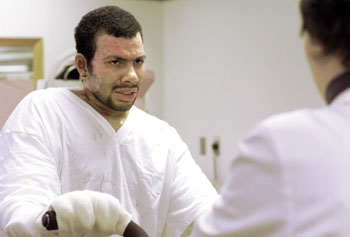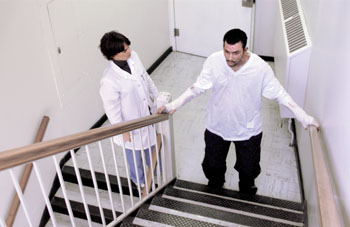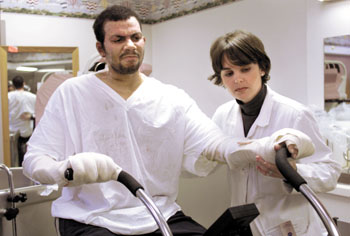
Focused on recovery, Jeremy Johnson peddles through pain during a physical therapy session. His faith-based decision to not receive blood transfusions has made his journey longer, but Johnson hasn’t lost his drive. (Photo by Dana Johnson)
Faith through fire – Religious conviction challenges patient, providers

One step up, then down, slowly and balanced, Jeremy and physical therapist Margaret Ann Montgomery work to stretch Jeremy’s taut skin. Therapy must be timed to allow his body enough rest and his blood levels to rise. (Photo by Dana Johnson)

Montgomery and other Burn Unit staff credit Jeremy’s determination and his family’s constant support with Jeremy’s recovery. But setbacks await. (Photo by Dana Johnson)
Standing at the nurses’ station in the Round Wing, Vanderbilt University Hospital’s venerable circular landmark, you can see into several patient rooms at once. It was designed for economy of care – one vantage point with multiple views, simultaneous insight into multiple patients’ conditions.
It’s a fitting setting for one patient who has called the Round Wing’s Burn Unit his second home since he was first admitted on Oct. 31. A look into Room 4445 at Jeremy Johnson affords insight into layers of complex challenges – medical, spiritual, ethical, and emotional.
Jeremy is a Jehovah’s Witness. One tenet of his faith requires that he avoid blood transfusions to preserve his soul for a “paradise on earth,” regardless of the effects to his physical body.
But burn victims are notorious for bleeding and needing transfusions. One cubic inch of skin carries eight feet of blood vessels. More than 58 percent of Jeremy’s skin on his 6-2 frame was destroyed by third-degree burns in an industrial accident on Oct. 23 in Stevenson, Ala. For weeks, Jeremy’s blood count hovered around 15, less than half what it should be.
Treating burns this severe is nothing new for burn specialists. Nor is treating Jehovah’s Witness patients with less severe burns. But Jeremy’s extensive burns make his case rare, said Dr. Jeffrey Guy, assistant professor of surgery, co-director of the Burn Unit and Jeremy’s physician.
But who should decide how much care is necessary? If receiving transfusions were Jeremy’s only hope to recovery, do health care providers have the right to supercede his personal beliefs? What about the cost of a higher level of care – more nursing hours to care for one patient? And how do those providers cope when they know their patient suffers while an option exists that would speed recovery?
The questions aren’t easy – for Jeremy or his staff. With blood transfusions, Jeremy could have been patched up in one or two operations over a few weeks’ time. But Jeremy elected to undergo several smaller procedures over months. In between, while his blood replenished itself, he was in pain so extreme he wanted to scream, and occasionally he did.
Painful as it is sometimes for Jeremy to speak, he doesn’t waiver when describing his faith. “I was always taught not to take blood of any kind,” he said, gritting through a physical therapy session. Jeremy isn’t even officially baptized as a Jehovah’s Witness. Not yet. But, he said, “I plan to be as soon as I get better. To take blood now would make me feel guilty when I start studying” the religion.
Respect for this patient’s stalwart beliefs tries the skill and acumen – and at times the emotional fortitude — of the nurses, therapists and physicians charged with healing his physical wounds. Vanderbilt has faced its own trials walking the fine line between providing medical care while treating the spirit.
“The burn unit staff are trained to save people’s lives, to take away their pain,” Guy said. “The staff knows we can make Jeremy more comfortable, get him back to his life more quickly,” Jeremy could be any of the staff’s brother, son, husband.
“Part of medicine is preserving people’s dignity, even if we can’t save his life. Jeremy’s life is very finite. If he got a unit of blood his soul will spend an eternity in hell,” Guy said.
The accident
Around 3:30 p.m. on Oct. 23, Jeremy and a co-worker were preparing to vacuum ash out of the boiler of a paper mill in northern Alabama. Jeremy’s brother, James Johnson III, is in the same environmental business. He explains that the mill is an older facility and access to the boiler is above head and off the ground. The ash in the boiler was supposed to be cool, James Johnson said. But when Jeremy and his co-worker opened the access door, hot ash spilled over them, covering them from head to toe. According to an industry spokesman, the temperature inside boilers during operation ranges from 200 degrees Celsius to 1,000 degrees Celsius.
The ash that burned Jeremy “was so hot, there was ash burning on the ground the next day,” his brother said.
Jeremy was transferred to Vanderbilt. “When we got here our nerves were raw,” said Desirae Pratt, Jeremy’s mother. “But Dr. Guy said he believed in treating the total man – physical, mental, emotional and spiritual. Here the whole staff has been very positive. We know we’re asking for an alternative treatment, but here it’s seen as a challenge.”
Jehovah’s Witness faith, Pratt said, literally interprets Acts 15:28, 29 from the Bible that directs people to abstain from blood. Followers carry this message with them in an advanced medical directive.
But, Pratt said, Jeremy and other Jehovah’s Witnesses want all other medical care. “We want to live like anybody else. We want the doctors to do everything – in the confines of our faith. Once the doctors do all they can, then we leave it in God’s hands,” she said.
Jehovah’s Witnesses take another Bible passage literally: Isaiah 33:24, which pamphlets interpret as promising “a paradise earth (where) all sicknesses and physical infirmities will also be healed.”
Ethical treatment vs. medical care
Providing care “is not simply a matter of deciding” a course of treatment for the patient, said Stuart Finder, Ph.D., director of the Center for Clinical and Research Ethics. “In a situation with a Jehovah’s Witness patient, there has to be a balance between what we think is right and what the patient thinks is right.”
For a Jehovah’s Witness, the risk of accepting a blood transfusion makes the health care provider’s religious belief irrelevant. “The goals for the patient far exceed the limited involvement of medical personnel. It goes beyond the hospital, deeper than flesh,” Finder said.
But there are limits to observing a patient’s wishes. Finder offered as an example the recent case of a surgeon at another Nashville hospital who honored a patient’s request to not allow black males in the operating room.
Caring for Jeremy by honoring his wishes also helps preserve the hospital’s social commitment to allowing freedom of expression. “It’s an example of how an individual act has social components,” he said.
On the other hand, it’s also the hospital’s responsibility to preserve if a patient’s request threatens to harm society.
Guy said he and his team have consciously steered away from discussing the “what ifs” in Jeremy’s care or questions about their patient’s faith. “It’s not my job to superimpose my religious beliefs on patients,” Guy said.
Besides, the surgeon said, it just might be Jeremy’s strong belief that’s carried him this far. It’s certainly been a boost to the nursing staff assigned to him. Without blood transfusions, Jeremy is not a candidate for a traditional skin graft operation – one that would take healthy skin from one part of his body to cover a burned section. Instead, he will receive a fairly rare cultured autograft – a few cultured strips of his skin will be grown into enough grafts to cover his wounds.
But first, Jeremy’s body must lie quiet while his blood count rises high enough to allow the surgery. One accident will stir his body, and his doctor’s commitment.
Next week, The Reporter will pick up Jeremy’s story from a major setback to a surprising outcome.













